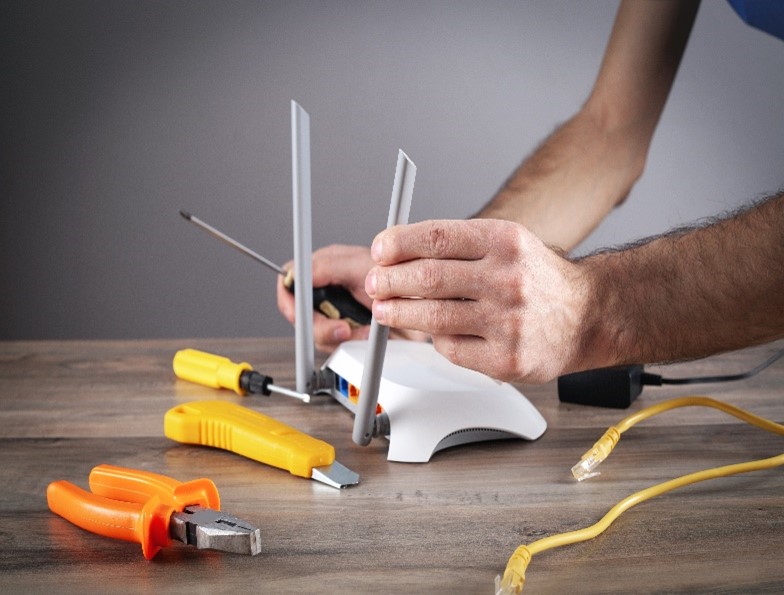Cybercriminals are increasingly targeting the home and small business user because they are generally less sophisticated and leave gaping holes in their digital security. There are several simple and free steps you can take to make sure you’re as protected as you can be
Best Practices for Digital Security at Home or in Your Small Businesses
Your Router
Your router is the gateway to all of your digital assets. If someone can get access to your router, they can essentially take over ever digital device our your wifi network including your phones, your smart tv, your digital assistants like Alexa, your security system, cameras and of course, your computers.
They then use this information to spy on you or watch your behaviors. They may be able to use a camera to see you punch in your security code for your alarm system or wait for you to leave the house so that they can break in or, God forbid, access the house while you or your family are home.
Take these few simple steps to secure your router.

Change your router password
If you have a cable or DSL modem from 2017 or prior, it probably has the username: “admin” and the password: “password.” Although cable companies have their own security setup to help stop penetration attempts to your router, the average cable modem sees about 100 penetration attempts a day. The first thing they look for is this username/password combination and it’s estimated that 40% of the routers installed in North America have this vulnerability.
Note, this is not the Password that you publicize for the wifi connection. It is the Password that administrates the machine. Kind of like the difference between your computer’s password to unlock the operating system and your email password. If someone gains access to the administrative password, they can do anything they want, including monitor all traffic going in and out of it.
If you have an older generation router, consider upgrading to a current model. They’re faster, more secure and inexpensive.
Change your router’s SSID
So many people broadcast an SSID that identifies themselves or their location. So, if someone is targeting you in particular, all they have to do is drive by sniffing for an SSID that they know is associated with you. Then they can focus on penetrating your router.
Physical Security

Keep your router in the center of your home or business, preferably in a locked cabinet. Even with a good password, access to the router allows a criminal to login directly with a wired connection and bypass the username and password authentication process. With routers “access is everything.” Keep it in a secure location. Do this with wifi extenders as well or buy wifi extenders that don’t have connector ports.
Your Devices
Make sure to turn these off when you’re not using them. Like computers, when you boot them up the next time, new security patches will be automatically installed. It is vitally important that you keep the latest security patches on these machines. They can be “patient zero” when a virus infects your network.

Cybercriminals are increasingly targeting the home and small business user because they are generally less sophisticated and leave gaping holes in their digital security. There are several simple and free steps you can take to make sure you’re as protected as you can be
There are simple steps you can take to help secure your devices, including your computers, gaming consoles, phones and IoT devices.
Phones
Turn your phone off at night. Not only is this a good habit for your sanity, it also prompts the apps on your phone to look for automatic updates when you restart it. If you are told by the manufacturer that there is a pending update, make sure it successfully completes. These are often security-related.
IoT Devices
Things like digital assistants, smart tv’s and connected home devices are all entry points for the cybercriminal. The best way to protect yourself from these attempts is to regularly change your SSID password.
Gaming Consoles

Make sure to turn these off when you’re not using them. Like computers, when you boot them up the next time, new security patches will be automatically installed. It is vitally important that you keep the latest security patches on these machines. They can be “patient zero” when a virus infects your network.
Computers
Like gaming consoles, be sure to turn them off (as opposed to sleep mode). That way, new security patches will be automatically installed for your operating system and main programs when you turn them back on.
If you must leave your computer in your car, put it in the trunk. While a cybercriminal may not actually steal it, he may just connect to it to penetrate it for his own uses. Better to just to keep it with you at all times, though.
Use XDR security software
Antivirus software is no longer robust enough to adequately protect your computers. Last year, they only stopped about 25% of all attacks. Extended Detection and Response systems combine real-time surveillance of your network (at eSure.AI, we only see 1’s and 0’s, not the content) by AI’s and Human Security Operations Center Expert that are constantly learning and implementing fixes and responses as they arise rather than once the malware is on your computer, which is increasingly too late.
 XDR is the state-of-the-art in computer security. At eSure.AI, it’s about the same price as the antivirus software you’re probably paying for, lightweight so it doesn’t slow your computer down, does not bug you with annoying pop-up messages and comes with a $1,000,000 service guarantee. Right now, we are the only provider of XDR to home and small businesses.
XDR is the state-of-the-art in computer security. At eSure.AI, it’s about the same price as the antivirus software you’re probably paying for, lightweight so it doesn’t slow your computer down, does not bug you with annoying pop-up messages and comes with a $1,000,000 service guarantee. Right now, we are the only provider of XDR to home and small businesses.
